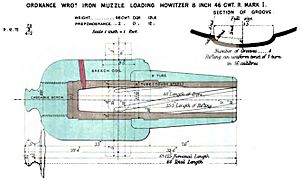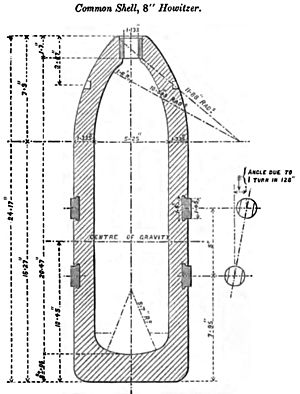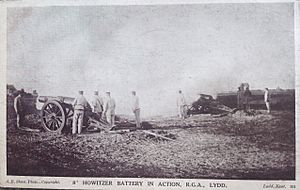RML 8-inch howitzer facts for kids
Quick facts for kids RML 8-inch howitzer |
|
|---|---|

RML 8-inch 46 cwt howitzer diagram, pub. 1879 (HMSO)
|
|
| Type | Howitzer |
| Place of origin | United Kingdom |
| Service history | |
| In service | 1872–1902 |
| Used by | British Empire |
| Production history | |
| Designer | Woolwich Arsenal |
| Manufacturer | Woolwich Arsenal |
| Variants | 46 cwt Mark I and II 70 cwt Mark I and II |
| Specifications | |
| Mass | 46-long-hundredweight (2,300 kg) |
| Crew | 9 |
|
|
|
| Shell | 180 pounds (82 kg) (common shell) 180 pounds (82 kg) (shrapnel) |
| Calibre | 8 inches (203.2 mm) |
| Action | RML |
| Breech | none – muzzle-loading |
| Muzzle velocity | 1,330 feet per second (405 m/s) |
| Effective firing range | 3,500 yards (3,200 m) |
The RML 8-inch howitzer was a powerful British weapon from the 1800s. It was a type of Howitzer, which is a cannon that fires shells in a high arc. This particular howitzer was "Rifled, Muzzle Loading" (RML). This means it had special grooves inside the barrel to make the shell spin, and it was loaded from the front. It could fire a shell weighing about 180 pounds (82 kg). These howitzers were mainly used to attack enemy forts or during sieges.
Contents
How It Was Designed and Made
This howitzer was built using strong materials. It had an inner tube made of tough steel. An outer tube of wrought iron was shrunk onto it, making it even stronger. A part called a cascable was added at the very end.
There were two main versions of this howitzer. The first one, weighing 46 cwt (hundredweight), had four spiral grooves inside its barrel. These grooves made the shell spin as it left the gun. Later, a heavier 70 cwt version was made. This one had 24 grooves and used special "automatic gas-checks" on its shells to help them spin.
The howitzer had flat surfaces on top. These allowed soldiers to use special tools to aim the gun. They could raise the barrel up to 30 degrees. This meant the howitzer could fire shells directly at a target or in a high arc over obstacles.
What Ammunition It Used
The two versions of the howitzer used slightly different shells. The 46 cwt guns used shells with small studs that fit into the barrel's grooves. The 70 cwt guns used shells with "automatic gas checks" instead of studs.
To fire the gun, a silk bag filled with black powder was used as propellant. The howitzer could fire three types of shells:
- Common shell: Used to destroy buildings or strong defenses.
- Shrapnel shell: Used against groups of enemy soldiers or cavalry.
- Case shot: Used at close range against soft targets, like unarmored troops.
To fire the howitzer, a copper tube was put into a small hole at the back of the gun. A soldier would pull a rope attached to this tube, which would ignite the powder and fire the shell. Different types of fuses could be used. Some fuses made the shell explode after a certain time or distance. Others made it explode when it hit something. A skilled crew could fire about one shell per minute.
How It Was Used
These howitzers were usually used in groups of four. Each howitzer was very heavy and needed a team of nine soldiers to operate it. In places like India, elephants were often used to pull these massive guns! An extra cart carrying ammunition was also pulled along with each howitzer.
Its History in Service
In the 1870s, the British Royal Artillery chose these Rifled Muzzle Loading howitzers. They were much better than the older, less accurate smooth-bore cannons and mortars. These howitzers could shoot much farther and more accurately.
They were not very easy to move around quickly. Because of this, they were often used by "Garrison batteries." These were groups of soldiers who stayed in fixed locations, like forts or strong defenses. For example, by the 1890s, Fort Widley had two of these howitzers. They were on special carriages that allowed them to be moved to different parts of the fort if needed.
Some of these howitzers were also used by reserve military units in the United Kingdom. For instance, the 2nd Kent Artillery Volunteers practiced with them at Lydd in 1903.
See also
Surviving examples
- A 70 cwt version of this howitzer can still be seen at Fort Rinella in Malta.



